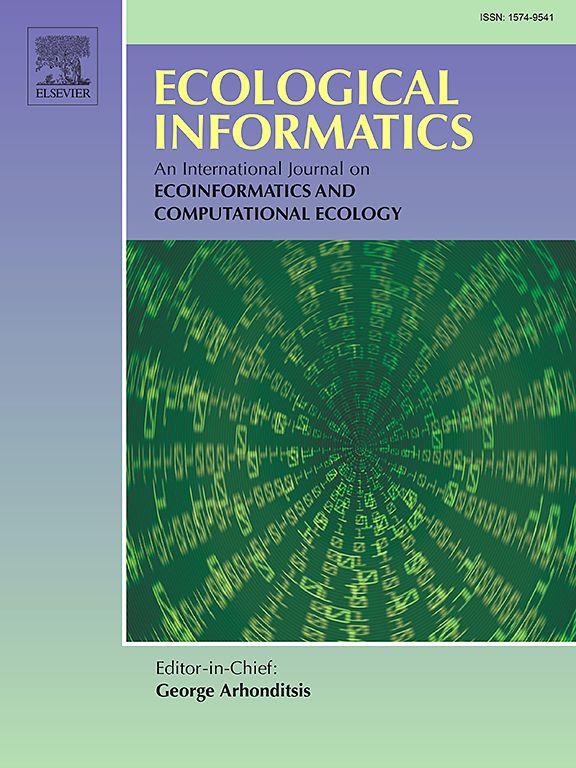几次迁移学习可以在景观尺度上对野生动物群落进行强大的声学监测
IF 5.8
2区 环境科学与生态学
Q1 ECOLOGY
引用次数: 0
摘要
用于生物声学物种检测的预训练分类器已成为大规模保护和自动生物多样性监测的可访问工具。尽管这些模型被广泛使用,但它们主要是在来自不同地区的高质量、弱标记物种记录上进行训练的,由于低信噪比和新声音(如非生物噪声和并发发声)的存在,这些模型无法解释被动环境声景数据的变化。这种域移位可能会限制预训练模型的可靠性,并妨碍其在实际声学监测中的应用。虽然在生物声学监测方面的研究相对较少,但迁移学习可以帮助克服现有预训练分类器的局限性,提高预测性能,同时避免开发全新模型所需的时间、资源和专业知识。我们演示了使用few-shot迁移学习作为一种策略,以最少的局部训练数据有效地将预训练的BirdNET源模型适应新的目标域。我们提出了一个开源的工作流程和指导方针,以评估具有生态意义的指标的性能,并训练具有改进或缺失类的目标模型,用于感兴趣的生物和非生物信号。通过对美国华盛顿州西部一个管理温带雨林景观的社区级声学监测的应用案例研究,证明了这一过程。目标模型在音频片段水平上的平均精确召回AUC为0.94,在场地使用水平上的平均准确率为92%,比预训练的源模型分别提高了0.15和13%。这些改进提高了单个物种检测的概率,并对当地物种丰富度进行了更准确的估计。一些高保护和管理优先级的物种不能被源模型可靠地检测到,但却取得了很高的性能。每个物种类平均只需要8个局部训练样例就能取得优异的性能。对其他感兴趣的信号(如昆虫、飞机、伐木、雨)进行新颖的培训,降低了混淆率,减轻了当地环境对性能的影响。Few-shot迁移学习利用预先训练的分类器的学习知识,在整个景观的社区级别实现健壮的监测,并提供一种可以很容易地应用于其他环境和分类群的方法。本文章由计算机程序翻译,如有差异,请以英文原文为准。

Few-shot transfer learning enables robust acoustic monitoring of wildlife communities at the landscape scale
Pre-trained classifiers for bioacoustic species detection have emerged as accessible tools for conservation and automated biodiversity monitoring at scale. Despite their wide use, these models are trained primarily on high-quality, weakly labeled species recordings from disparate regions that can fail to account for variation in passive ambient soundscape data due to poor signal-to-noise ratio and the presence of novel sounds such as abiotic noise and concurrent vocalizations. This domain shift may limit a pre-trained model's reliability and preclude its use in applied acoustic monitoring. Although relatively underexplored in bioacoustic monitoring, transfer learning may help overcome the limitations of existing pre-trained classifiers by enhancing predictive performance while avoiding the time, resources, and expertise required to develop entirely new models. We demonstrate the use of few-shot transfer learning as a strategy to efficiently adapt a pre-trained BirdNET source model to a new target domain with minimal local training data. We present an open-source workflow with guidelines to evaluate performance with ecologically meaningful metrics and train a target model with improved or missing classes for biotic and abiotic signals of interest. This process is demonstrated with an applied case study of community level acoustic monitoring across a managed temperate rainforest landscape in western Washington, United States.
The target model achieved a mean precision-recall AUC of 0.94 at the audio segment level and a mean accuracy of 92 % at the site use level across trained avian species classes, an increase of 0.15 and 13 % over the pre-trained source model, respectively. These improvements increased the probability of individual species detection and produced more accurate estimates of local species richness. Several species of high conservation and management priority that could not be reliably detected by the source model achieved high performance. Superior performance was achieved with an average of only 8 local training examples per species class. Training novel classes for other signals of interest (e.g., anurans, insects, aircraft, logging, rain) reduced confusion rates and mitigated the impact of the local environment on performance. Few-shot transfer learning leverages the learned knowledge of a pre-trained classifier to enable robust monitoring at the community level across the landscape and offers an approach that can be readily applied to other environments and taxa.
求助全文
通过发布文献求助,成功后即可免费获取论文全文。
去求助
来源期刊

Ecological Informatics
环境科学-生态学
CiteScore
8.30
自引率
11.80%
发文量
346
审稿时长
46 days
期刊介绍:
The journal Ecological Informatics is devoted to the publication of high quality, peer-reviewed articles on all aspects of computational ecology, data science and biogeography. The scope of the journal takes into account the data-intensive nature of ecology, the growing capacity of information technology to access, harness and leverage complex data as well as the critical need for informing sustainable management in view of global environmental and climate change.
The nature of the journal is interdisciplinary at the crossover between ecology and informatics. It focuses on novel concepts and techniques for image- and genome-based monitoring and interpretation, sensor- and multimedia-based data acquisition, internet-based data archiving and sharing, data assimilation, modelling and prediction of ecological data.
 求助内容:
求助内容: 应助结果提醒方式:
应助结果提醒方式:


